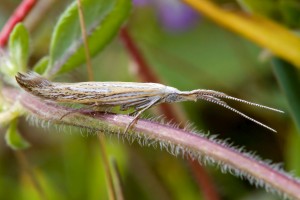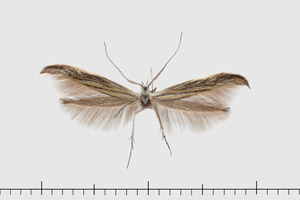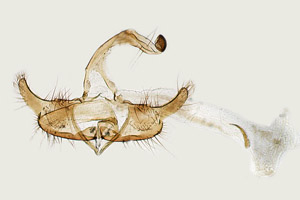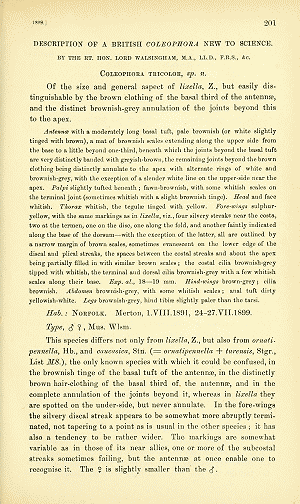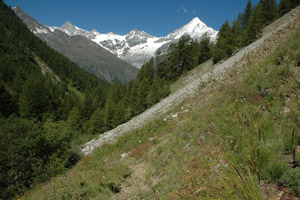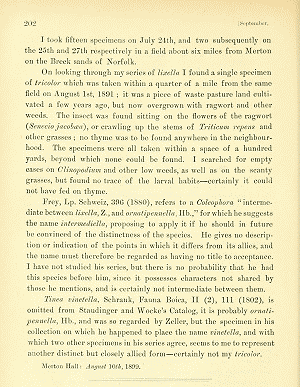2. Diagnose
2.1. Männchen
2.2. Genitalien
2.2.1. Männchen
2.3. Erstbeschreibung
3. Biologie
3.1. Habitat
3.2. Nahrung der Raupe
- [Lamiaceae:] Acinos arvensis [= Calamintha acinos, Satureja acinos] (Feld-Steinquendel)
Walsingham (1899) stellte fest, dass es an der Fundstelle seiner neuen Art keinen Thymian gibt - klären konnte er die Biologie aber nicht. Emmet et al. (1996: 277) halten in ihrer "historical note" fest: "R.W.J. Uffen (1963), recognizing that it was very closely related to C. lixella, surmised that it might have a similar life history and would start feeding in the seedpod of a labiate. He decided that the labiate most closely associated with the moth's habitat was basil thyme and confirmed his suspicion by netting adults flying over that plant. Seedheads were picked in September and some were found to contain larvae. It was expected that the larvae would, like those of lixella, switch to grass, but it was wrongly thought that, like that species, they would not do so until spring. Consequently the first batches of larvae were lost in the winter. Later, when unidentified grass taken from the locality was provided in the autumn, it was found that the larvae overwintered in cases spun in grass and rearing was successfully accomplished, by J.M. Chalmers-Hunt in 1971 and by A.M. Emmet in 1974. As far as is known, none has been reared since. Chalmers-Hunt (1975) promised a paper by himself and Uffen giving an account of the history and rearing of this species, but it has not yet been published and this, therefore, is the first account of the life history."
4. Weitere Informationen
4.1. Faunistik
Locus typicus ist die Grafschaft Norfolk in England. Emmet et al. (1996: 276-277) können nur von wenigen Fundorten im Südosten Englands berichten.
Baldizzone, Nel & Landry (2014: 132-133) wiesen die Art durch Barcoding außerdem in Frankreich (Provence-Alpes-Côte d’Azur, Hautes-Alpes) und Griechenland (Mazedonien, Kozani, nahe beim Dorf Xirolimni) nach.
Huemer & Wieser (2023) wiesen die Art erstmals für Italien nach: "Prov. Torino, Fenestrelle E, Depot, 1090 m, 45.028◦ N, 7.052◦ E, 11.7.2021, leg. Wieser, DNA Barcode ID KLM Lep 15810."
Der oben gezeigte Belegfalter von Rudolf Bryner aus dem Wallis scheint der erste gesicherte Nachweis für die Schweiz zu sein. Bryner & Kopp (2023: 47) fanden aber doch eine ältere Angabe, die dadurch bestätigt wurde: "Die einzige Meldung aus der Schweiz stammt von Uffen (1967), der die Art auf dem Simplonpass (VS) im Juli 1967 auf Acinos arvensis fand. Emmet et al. (1996) erwähnen, dass dies der einzige Fund der Art vom europäischen Festland sei. Jetzt liegen weitere Funde aus dem Wallis vor: Zermatt (VS), Trift, 2200 mü.M., 622/097, 17.7.1982, Falter (gen. det S. Whitebread.) auf Blüte von Acinos alpinus; Täsch (VS), Täschalpen, 2200 mü.M., 628/101, 23.7.2008, Tagfang, zwei Männchen (GP 2008-111) (leg. R. Bryner); Erschmatt (VS), 1300 mü.M., 20.6.2014; Binn (VS), 1350 mü.M., 23.6.2017 (beide leg. W. Wittland)."
(Autoren: Erwin Rennwald & Jürgen Rodeland)
4.2. Typenmaterial
Baldizzone (1994: 141) designierte einen Lectotypus: “Il Lectotypus ♂ [designato in questa sede] reca le seguenti etichette: 1) “LECTOTYPE” (rotondo, orlato di rosso); 2) “TYPE H.T.” (rotondo, orlato di rosso); 3) “Merton, NORFOLK, 1.VIII. 1891 Wlsm. 84523” (a mano e stampa); 4) “Walsingham Collection 1910-427” (a stampa); 5) “COLEOPHORA TRICOLOR Wlsm. Ent. Mo. Mag. XXXV 201-2 (1899) TYPE ♂” (a stampa e mano); 6) “B.M. ♂ Genitalia slide No. 2804” (a stampa e mano). L'esemplare, in buone condizioni, è conservato insieme a tutta la seria originale presso il BMNH.”
4.3. Literatur
- Lectotypus-Festlegung: Baldizzone, G. (1994): Contribuzioni alla conoscenza dei Coleophoridae LXXV. Coleophoridae dell'Area Irano-Anatolica e regioni limitrofe (Lepidoptera). — Associazione Naturalistica Piemontese Memorie 3: 1-423. Stenstrup (Apollo Books).
- Baldizzone, G. (2023): Contribuzioni alla conoscenza dei Coleophoridae (Lepidoptera). CLVII. Descrizione di due nuove specie italiane del genere Coleophora Hübner, 1822: Coleophora gurgurella sp. nov. e C. bruttia sp. nov. Segnalazione di tre specie nuove per la fauna italiana e nuove informazioni biologiche e distributive. — Gortania (Botanica, Zoologia) 45: 71-94. [PDF auf museofriulanostorianaturale.it]
- Baldizzone, G., Nel, J. & J.-F. Landry (2014): Coleophora nepetellae Baldizzone & Nel, a new species of the C. lixella group (Lepidoptera, Coleophoridae) from France and Italy. — ZooKeys 459: 119-135 (02 Dec 2014); doi: 10.3897/zookeys.459.7983. [Online-Publikation auf zookeys.pensoft.net]
- Bryner, R. & A. Kopp (2023): Aktualisierung der Checkliste der Schmetterlinge (Lepidoptera) der Schweiz. — Entomo Helvetica 16: 39-60.
- Emmet, A.M., Langmaid, J.R., Bland, K.P., Corley, M.F.V. & J. Razowski (1996): Coleophoridae. - S. 126-338. In: Emmet, A.M. [Hrsg.](1996): The moths and butterflies of Great Britain and Ireland. Volume 3. Yponomeutidae - Elachistidae. - 452 S.; Colchester, Essex.
- Huemer, P. & Wieser (2023): DNA Barcode library of megadiverse Lepidoptera in an alpine nature park (Italy) reveals unexpected species diversity. — Diversity 2023 (15), 214: 1-12. https://doi.org/10.3390/d15020214. [zur Arbeit mit PDF-Download auf mdpi.com]
- Richter, I. & G. Baldizzone (2025): New faunistic and biological records on Coleophoridae from the Balkans (Lepidoptera). — Lepidopterologica Hungarica 21: 27-39.
- Erstbeschreibung: (1899): Walsingham, [T.] (1899): Description of a Coleophora new to science. — The Entomologist's Monthly Magazine, Second Series 10 (= 35): 201-202. London (Gurney & Jackson).


![Vorkommen in der Schweiz [Belegfoto aus dem Wallis]](/res/img/flag/ch.png)

![Vorkommen in Großbritannien [Agassiz, Beavan & Heckford (2013): Checklist of the Lepidoptera of the British Isles]](/res/img/flag/gb.gif)
![Vorkommen in Frankreich (europäisches Territorium ohne Korsika) [Vandromme et al. (2020): Liste systématique et taxinomique des Lépidoptères de France]](/res/img/flag/fr.gif)
![Vorkommen in Italien (Festland und kleine festlandsnahe Inseln) [Huemer & Wieser (2023) [siehe Faunistik-Text]]](/res/img/flag/it.gif)
![Vorkommen in Albanien [Richter & Baldizzone (2025: 31)]](/res/img/flag/al.gif)
![Vorkommen in Griechenland (Festland und festlandsnahe Inseln) [[siehe Faunistik-Text]]](/res/img/flag/gr.png)
![Vorkommen in Armenien [Baldizzone (2024)]](/res/img/flag/am.gif)
